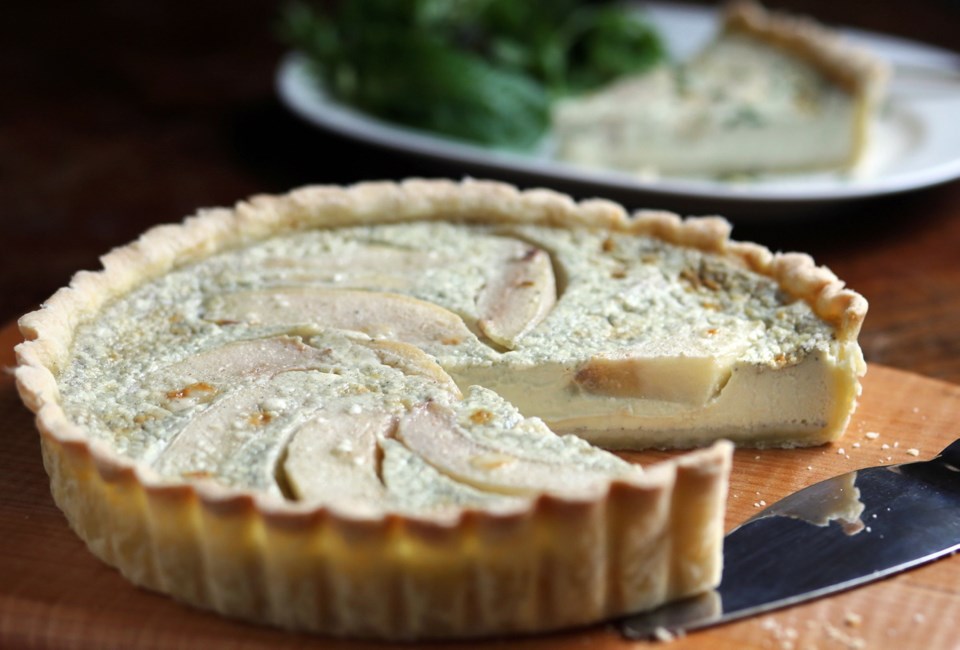 Dear Eric: About eight months ago my appetizer at a lovely place called Les Retrouvailles in Lyon, France, was a flan-like dish with pears and Roquefort. It was thin, no more than two centimetres thick, had no top pastry layer, probably an egg base for the filling with a delicate pear and Roquefort flavour. Any ideas how to make it?
Dear Eric: About eight months ago my appetizer at a lovely place called Les Retrouvailles in Lyon, France, was a flan-like dish with pears and Roquefort. It was thin, no more than two centimetres thick, had no top pastry layer, probably an egg base for the filling with a delicate pear and Roquefort flavour. Any ideas how to make it?
Peter
��
Dear Peter: I saw this style of dish in France a few years ago, but couldn’t remember exactly how it was made. I knew it was egg-based, though, and that clue and some research lead me to discover a few similar creations.
All had a rich, custardy filling, where tangy, wonderful and blue/green-streaked Roquefort cheese was blended with eggs, cream and/or milk, sour cream and seasonings. That filling was then poured over sliced pear and baked.
In one case there was no crust in the baking pan, simply a coating of breadcrumbs. But Peter said the dish he had did have a pastry bottom and in the variations I found, puff pastry or, more frequently, pâte brisée was used.
Pâte brisée is known as a short crust pastry because its rich butter content makes it more delicate than other types and it’s what I used in my recipe for Roquefort and pear flan.
To make it, you’ll need a false bottom flan (tart) pan, which has a removable bottom that makes it easier to unmould the flan once baked.
To ensure a crisp crust, it’s blind-baked for 15 minutes before filling. To prevent the crust from puffing during that process, you line it with foil and fill it with raw rice, dried beans or pie weights.
My flan filling was about two centimetres thick, similar to what Peter described, but my crust rose higher than that to ensure none of the precious filling spilt over it.
I made the flan the day before serving it and I’m glad I did. It’s fussy to make and preparing it in advance let me get things cleaned up well before my guests arrived.
If you do it make it in advance, you can serve the flan cold or at room temperature, which is what I did. You could also heat it in the oven a while, unmould and serve it warm. The flan can be sliced into small wedges and be served as an appetizer, or be cut into larger wedges and served as a main course for lunch.
��
Roquefort and Pear Flan
This ultra-rich, savoury flan with sweet pear can be served as an appetizer or main-course with a side salad. Be sure to use a ripe pear, not a firm, unripe one, as the latter will be difficult to slice through even when cooked.
��
Preparation time: 45 to 60 minutes, plus chilling time
Cooking time: 65 to 70 minutes
Makes: 8 to 12 servings
��
For the crust
1 1/2 cups all-purpose flour
• pinches sugar and salt
1/3 cup cold butter, cut into small cubes
2 Tbsp cold vegetable shortening or lard
1/2 cup ice-cold water
• dried beans or rice or pie weights
• vegetable oil spray
Combine the flour, sugar and salt in a large bowl, or bowl of your stand mixer.
With a pastry cutter, two forks, or with the paddle attachment of your stand mixer, cut the butter and shortening (or lard) into the flour mixture until thoroughly blended.
Add the water and gently work it until it forms a loose dough. Transfer the dough to a lightly floured work surface. With lightly floured hands, knead and shape the dough into a ball. Press the dough into a 1.25 centimetre thick disc.
Wrap, refrigerate and rest dough 20 minutes.
Lightly grease a 25-centimetre round, 5-centimetre tall, false bottom flan (tart) pan with vegetable oil spray.
Set the rested dough on a floured surface. With a lightly floured rolling pin, roll the dough from the centre out into a round about 7.5 centimetres wider in diameter than the pan. When rolling, turn the dough an eighth of a turn after each roll; this will help create a round shape. Sprinkle additional flour on the rolling pin and under the dough as necessary.
Carefully fold the rolled dough in half and lay it across the centre of the pan. Carefully unfold and gently nestle it into the pan. Trim off excess dough reaching over the pan.
Prick the bottom of the dough several times with a fork. Refrigerate crust 20 minutes.
Preheat the oven to 400 F. Cut a piece of aluminum foil large enough to cover the bottom and up the sides of the crust and carefully set in the pan. Top the foil with 1 1/2 cups of dried beans or rice, or with pie weights.
Bake the crust for 15 minutes, until partially cooked and light golden around the edges. Cool the crust to room temperature. Carefully remove the foil and the beans or rice (save them for future blind baking) or pie weights. Cool the pastry shell to room temperature and it’s ready to be filled.
��
For the filling and to finish
3 1/2 ounces (100 grams) Roquefort cheese
2 tsp lemon juice
1 tsp honey
1 ripe, medium anjou or bosc pear
1/2 cup half and half (10 %) cream
3 large eggs
1/4 cup sour cream
3/4 cup milk
1/8 tsp ground nutmeg
• salt and white pepper to taste
1 Tbsp chopped fresh parsley
��
Place the juice and honey in a bowl. Peel the pear, quarter it lengthwise and remove the core. Cut each pear quarter, lengthwise, into three slices, set in the bowl and toss to coat.
Arrange the pear slices in spiral-like fashion in the pastry shell.
Preheat the oven 350 F. Put the cheese in a second bowl with 2 Tbsp of the cream.
Mash the cheese with the back of spoon, and then mix in the rest of the cream. Beat in the eggs.
Add the remaining ingredients, except parsley, and whisk until smooth.
Pour the cheese mixture into the pastry shell. The pears may rise to the surface and that’s OK. Bake the flan in the middle of the oven for 50 to 55 minutes or until the filling is set.
Cool flan on a baking rack until firm enough to unmould and slice — about 30 minutes. Or let the flan completely cool, cover and refrigerate until ready to serve. If you do that, the flan could be made up to a day in advance.
Serve it cold, at room temperature or cover and warm in 300 F oven for 30 to 35 minutes and then unmould, slice and serve warm.
Eric Akis is the author of The Great Rotisserie Chicken Cookbook (Appetite by Random House). His columns appear in the Life section Wednesday and Sunday.



